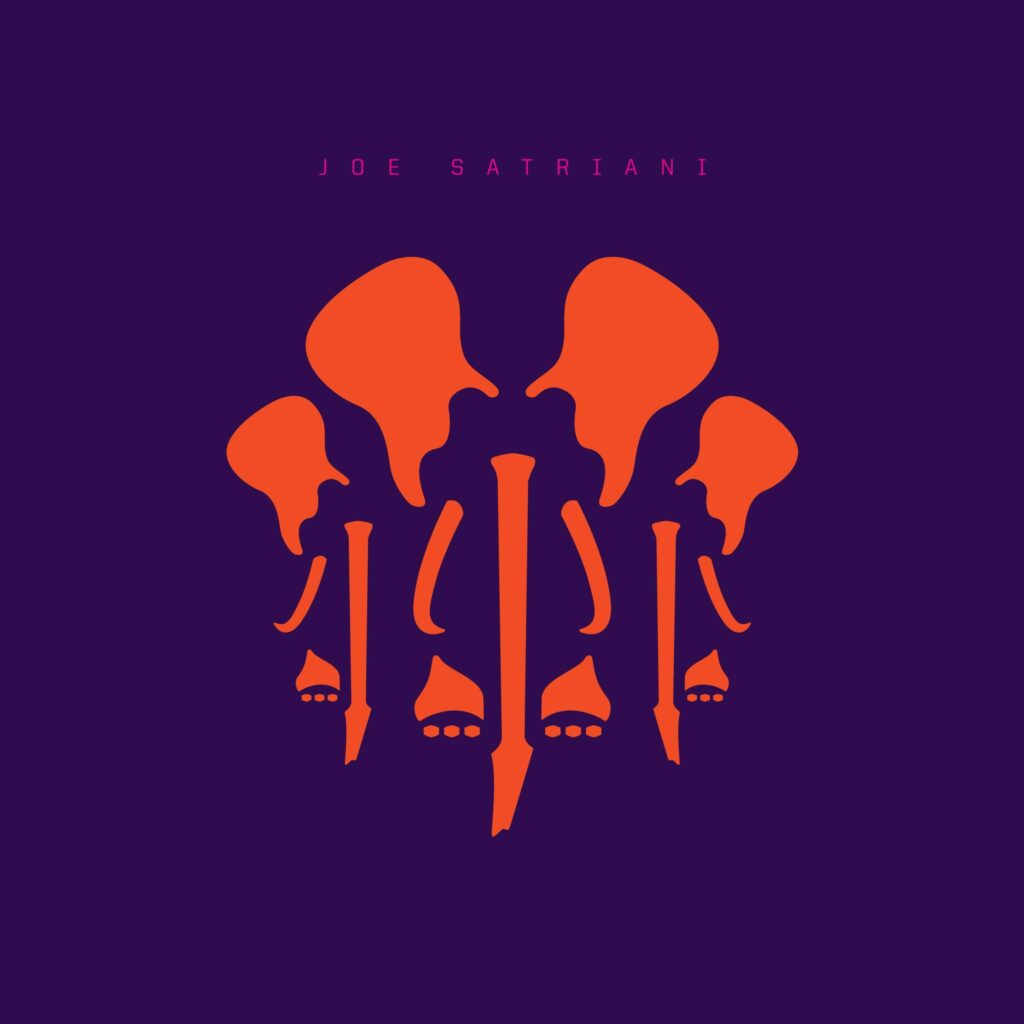Back In Satch: A Conversation with Joe Satriani
It was January of 1988 and a young, then-curly haired gunslinger named Joe Satriani was about to embark on his first tour as a solo artist in support of his now-famous “Surfing With The Alien” album, a landmark platter released in October of 1987 that drew rave reviews from both lovers of guitar-based instrumental rock music, and those who just enjoyed good, catchy hard rock in general.
Having been in a number of bands prior, Satriani was no stranger to the stage. But now, things suddenly felt … different.
Fortunately, Satriani was a quick study. The New York-born guitarist found his lane fairly quickly and has stuck to that successful template for more than three decades and 19 albums, including his latest, “The Elephants Of Mars.” Just when you thought there couldn’t possibly be any musical stones left to be turned by Satriani, he proves you wrong with his expert blending of simple musical hues in “Faceless,” the funk-riddled gem, “Pumpin’,” or the title track and it’s sonically unique construct

“The Elephants Of Mars” is auditory proof that there’s still plenty of gas left in Satriani’s tank — or charge left in his battery, whatever energy metaphor suits you. The bottom line is Satriani is still very much a player in the music game, in every sense of the word.
Satriani brings his musical genius and backing band of Kenny Aronoff (drums), Bryan Beller (bass) and Rai Thistlethwayte (keyboards) to Hoyt Sherman Place in Des Moines this Friday night, Oct. 7, on his “Earth 2022-2023 Tour.”
Satriani spoke to ListenIowa recently about the new album, stretching his creative boundaries, and how Marvel once made him an offer he could refuse.
ListenIowa: Congratulations, Joe, on the latest release, “The Elephants Of Mars,” of which you’re on tour now supporting as well. What’s the reaction been to the album and the live show?
Joe Satriani: It’s been great. There’s a feeling of celebration and ecstasy to be able to go out onstage again and play for all of our fans who haven’t seen us since the G3 tour in 2018, or the Experience Hendrix tour in ’19. It feels great, like the tribe is finally getting together to celebrate. It’s doubly great because we didn’t get to tour behind “Shape Shifting” as well, so we’re playing a lot of new music from both albums.
LI: How many of these new tracks are you incorporating into the live set?
JS: It’s almost half the set, actually. We always like to make sure we play what we call “the hits,” and we always leave room for the individuals in the band to so some solo spots. Normally, we’d play six songs (from a new album), maybe less. What usually happens is you hit the road just as an album comes out and there’s really no time for people to get familiar with the material. But in this particular case, with this lag (the pandemic) before we hit the road, it’s played in our favor. The fans have had a lot of time to digest both new albums.
LI: “The Elephants Of Mars” is a fantastic sonic journey with twists and turns here and there. Did you go into this album with any ideas in mind of what you wanted to create?
JS: Definitely. I was thinking that I needed to create some new parameters for myself to challenge what I’d just done, which was kind of a traditional, old-school record (“Shape Shifting”). That was done in a studio with a band sitting — or standing — in the same room. When I started to think about “The Elephants Of Mars,” I thought I had to do something entirely different.
LI: In what way?
JS: Well, we couldn’t get together because of the pandemic, so I asked myself what I could do to make the situation work in my favor? And that was write better songs, play better guitar, encourage myself and my bandmates to do better arrangements than we’ve ever done before, and also not to try to recreate any kind of recording vibe from the past. I’ve done that before, like with “The Extremist” in 1992. I wanted that to kind of sound like a classic rock record. I missed that era. I was too young. But this time around I wanted to forget all of that and just entertain everyone’s wildest dream about how they want to see their performances on the album. And it helped that everyone got to record on their own. They didn’t have to worry about the time clock. There wasn’t a schedule. If any part took three weeks, that was OK, and I think that’s what made it unique.
LI: Speaking of dreams, one of the songs,“Faceless,” begins with a very simple piano hook, which eventually leads to your guitar accompaniment and even some orchestral parts. Very dream-like in its presentation and compositionally an excellent song.
JS: I’m happy you like that. We really wanted to keep that strong and powerful emotionally. The piano figure in the beginning had to kind of sound lonely, because that’s what the song is about, someone who feels that the people closest to them — loved ones, family, friends, community, country, maybe even the world — don’t recognize them for who they truly are. It wasn’t about mask wearing, although that may have entered my mind, as where I live now, in San Francisco, we had a strong mask mandate. But this really got me thinking how isolated people feel when they’re not recognized for their true nature. So we intentionally didn’t want to make the song too big, and kept that lonely hook in the beginning. We didn’t want it to have too many guitar tracks accompanying it; it need to maintain that loneliness.
LI: Where did the title track name come from?
JS: (Laughs) These things just kind of pop into my head and I kind of laugh when they do because sometimes they just silly. I’d actually had this track as cue music for an animated TV show that my writing partner and I were working on many years ago. It eventually turned into the “Crystal Planet” comic book line. We never got the TV show, so I had all of these cues that I had been writing. But I had this one sound that really did sound like gigantic, alien elephants of some kind. I really wanted to turn it into a full song, so I kind of fixed it and sent it to my co-producer Eric Caudieux, my main producer on this record. He loved the weird song effects and re-arranged my guitar solo into this really dreamy breakdown section. Each time someone would work on their part, it would get emailed around, and we’d all react to it like, “Oh my God. What happened to that song? It’s so much crazier now.” And then everyone would contribute to it again. I asked for the guitar solo section to be extended for about three minutes, with no intention of filling it up. But one day I was playing along from beginning to end and it just seemed to capture the craziness of this story I’d built up.
LI: And what is the story behind all these sounds, as it pertains to the song itself?
JS: The story is that, in the future Mars has been terraformed, and colonists are starting to live there. Earth corporations are mining the hell out of the place and are hell-bent on destroying this newly-terraformed planet. Unbeknownst to them, thanks to a revolutionary rock star colonist, they discover there’s a race of gigantic elephants that had been created as kind of a side effect of this terraforming. They communicate to this rock star and decide to revolt and take over the planet and make it the beautiful garden planet that it should be. After the narrative was written and cleaned up, I was able to tell it to the other guys in the band, and after we finished laughing, we thought, “This is a great mental movie to help us perform properly.” With musicians, they often show up being kind of straight and professional, so you have to break them down and say, “You can be crazy. You can laugh at this and do what you want to do.” That really let everybody free.
LI: The album cover is ingenious as well.
JS: Isn’t that amazing? That’s Todd Gallapo at Meat and Potatoes. I’ve known him since the first Chickenfoot album. He designed the logo for that and a number of other albums with me. I actually sent him that track because he wanted to know what the music was like. He got so inspired that I don’t think it took him more than an hour to email be back and say, “I’ve got this crazy idea. I’ve figured out a way to take your guitar apart and turn it into elephant parts.” His very first draft was very close to what the album cover is.
LI: I want to take you back to 1988 to the “Flying In A Blue Dream” album where you dove headfirst into the vocal realm. You had six songs featuring you on lead vocals. Since then, you’ve had vocals on tracks here and there, but not much. Was that just something you had to get out of your creative system at that point?
JS: It was a funny moment. I thought I was going to do what I’d been doing in all of these rock bands I’d been in — just not sing. But I felt like I was missing that connection to the audience, because it’s really powerful when you sing to an audience. You’re using a language they understand. The human voice is the main form of communication. I missed that, so I kept thinking that maybe my audience that will know that I’m not trying to be a singer, I’m just trying to make the albums more interesting, so I decided to sing in character. That’s what the six songs on that album sound completely different. I made no attempt to be a real singer. I just thought I’d be a different character for each song like “Big Bad Moon” or “I Believe” or “Strange.” Three different guys. I think everybody knew that it wasn’t a real singer’s voice, but that it was OK. It’s just Joe having fun.
LI: You stepped back away from having vocals on your albums soon thereafter, though. Why was that?
JS: As the success of the albums moved on, I started to realize that I had grown into this form of communicating without having to sing. It had to do with writing better melodies and learning how to perform them onstage, as if someone was singing with important lyrics that were going to mean a lot to people. It became this real bonus, because when I’d play in India or Finland, the language barrier didn’t matter anymore; it was just melody. When I’d play in a cricket field in Mobai, they’d all sing the melody for “Flying In A Blue Dream.” I realized I didn’t need lyrics. The melody was connecting. So I’ve always focused on that melody. It’s a lot of work. It’s not like when you have a singer in the band; it’s a whole other kind of discipline. But I really enjoy it.
LI: The album that really put you on the map for that template was “Surfing With The Alien” of course. The original artwork featured the Marvel character, the Silver Surfer, but now he’s gone from the covers. What happened?
JS: When we secured the license for the original Silver Surfer artwork, Marvel was in really bad shape. They had retired the series. No one was interested in it. This was 1987. They gladly charged us $5,000 for a 20-year license. But as the album became multi-platinum, and Marvel became a blockbuster movie franchise, each time we’d go to re-do the license, it would get more and more intense. Finally, they asked for hundreds of thousands of dollars and wanted original music, too. Basically, they made me an offer I could never accept. (Laughs) But they didn’t want to say “no,” so they made me an offer that was cruel beyond belief. So we found out that they hadn’t actually copyrighted all of the elements, just the way the surfboard was fixed on the cover. So we had to change it for legal reasons. That was Todd again, working with a comic book artist, to find a way to not upset fans but also to not upset Marvel. (Laughs)
LI: That’s surprising that you’d get that kind of treatment, especially with how much exposure the album gave Marvel with its success.
JS: I’ve been to the actual Marvel office in New York City, and I’d always thought they’d be welcoming. But they haven’t been. I do understand they’re embracing whatever the most popular form of music is at the time, which in the last 20 years has been hip-hop and pop, so I bear no ill-will toward them at all.
LI: “It’s just business,” as they say.
JS: What’s really great is that I get to tell the story about how the album wasn’t originally called “Surfing With The Alien.” It was called “Lords Of Karma.” During my first interview, the journalist didn’t like the title of the album; it was something he said in passing as he said goodbye. So I called up the label, and they hadn’t picked the artwork and gone into production yet, so I said, “Let’s change the album title to something humorous so people don’t think I’m a serious nutcase. Let’s pick ‘Surfing With The Alien’ so they’ll know I have a sense of humor.” So the production manager, Jim Kozlowski at Relativity Records, just happened to be 6-foot-4 with long blonde hair, and his nickname just happened to be “The Silver Surfer.” So he suggested, as a joke, that we put his nickname-sake — the Silver Surfer — on the cover. One thing led to another, and he lived a block from Marvel, so he just walked down there and told them this was for an instrumental artist, can we use some art? They said “Sure. Help. We need money.” (Laughs)
LI: Your lead playing and sense of melody have always been your trademarks, but let’s talk about your rhythm playing. How much emphasis do you place on it, and do you think it’s an under appreciated skill?
JS: It is for all players, whether it’s George Harrison or Keith Richards. They don’t get the credit they deserve. But no song gets finished unless that foundation is there. Keith Richards knows that. The riff is the “thing.” Solos come and go. Even if they’re promoting some new technique that no one’s heard before, it instantly becomes learned by every up-and-coming generation, and it sort of becomes diffused. Sort of like Eddie Van Halen with finger tapping. That was not his real, true genius. His true genius was his writing. He played rhythm guitar most of the time in the band. He had impeccable timing, both he and his brother, Alex. They made the music just so much fun to listen to. Even when he approached a solo, he would just improvise and pick the best version. He knew that rhythm playing was so important. We start all these tracks knowing that. It’s just so important. Even when I do Chickenfoot, playing rhythm guitar is just so much fun. You get to hang out with the drummer and the bass player. It’s different than when I’m doing my gig. I’m basically replacing the singer, so I’m kind of floating on top. But when you’re in the rhythm section, you really get to play the guts of the song.
LI: Speaking of Chickenfoot, Joe, is there a future left with the band? It’s been awhile now. Or is what we have now what we’re going to get?
JS: (Laughs) I’m always pushing the guys to try to figure out a way to do another album. I realize we have a lot of music between us to share. But the Chili Peppers have a new album, I think Sammy has a new album, and we’re out on tour. So the schedule doesn’t look good. (Laughs) But we’ll see what happens. No one is saying it won’t. It always could happen. Usually with Chickenfoot things happen within 24 hours. (Laughs) “Can you be here and bring your guitar so we can record three songs?” (Laughs) So I’m always ready. I’ve got my bags packed and ready to go.
LI: Last question. If you were to give the 1986 “Not Of This Earth” Joe Satriani some advice from 2022, what would that be?
JS: (Laughs) Stack up on some razor blades. I had hair back then. No, I’d probably say not to worry about acceptance. It’s the same thing all artists worry about when they’re starting out. They compare themselves to every other artist out there and wonder if they’re going to be accepted for their oddness or uniqueness. And as it turns out, that’s exactly what people want. They don’t want the same thing. They want to be surprised. Artists need to remember that: their uniqueness is their superpower.
By Darren Tromblay
Joe Satriani: Earth Tour 2022-2023
Friday, October 7, 2022
8 p.m.
Reserved Seating: Advance $44.50, $59.50, $74.50
(Day of Show: +$3)
BUY TICKETS


